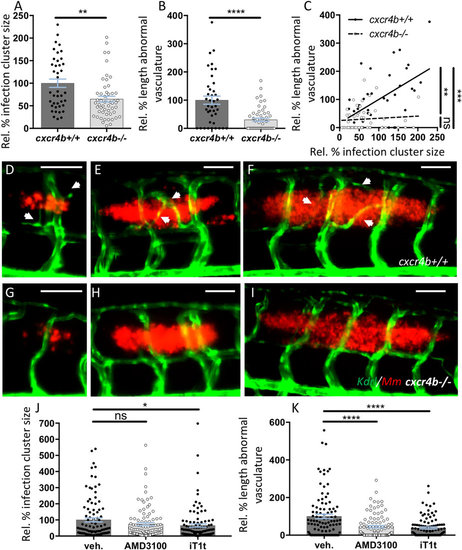Fig. 2
- ID
- ZDB-FIG-170505-22
- Publication
- Torraca et al., 2017 - The chemokine receptor CXCR4 promotes granuloma formation by sustaining a mycobacteria-induced angiogenesis programme
- Other Figures
- All Figure Page
- Back to All Figure Page
|
Cxcr4b mutation impairs granuloma-induced angiogenesis. (A,B) cxcr4b mutants display a reduced expansion rate of local granulomatous lesions (A), which coincided with the incapability to induce an angiogenic programme (B). (C) Vascularisation/granuloma expansion correlation analysis. In wt, the expansion of the granulomas depends on the activation of the angiogenic programme at the infection focus. Differently, in cxcr4b mutants, no significant correlation between granuloma size and vessel length could be observed and even large granulomas failed to initiate angiogenesis, suggesting that the differential activation of the angiogenic programme is not the effect, rather the cause, of reduced burden in mutants. Aberrant vasculature was measured as the two-dimensional length of vessels not found in uninfected larvae and that solely form in association to granulomas. Infection cluster size was measured as the two-dimensional area of individual trunk lesions. Values are expressed in percentage relative to average infected cxcr4b+/+ (set to 100%). Statistics in C indicates that the slopes of cxcr4b−/− and cxcr4b+/+ trend lines are significantly different (linear regression comparison test) and that in wt (but not in mutants) this slope is different from 0 (x axis, Pearson correlation test). Each data point in A-C refers to individual trunk granulomas at 5 dpi. Experiments were performed in 3 replicates (cumulated in the graphs), each with 4–12 larvae per group. Total number of granulomas analysed: 40 (cxcr4b+/+), 52 (cxcr4b−/−). (D–I) Representative images of comparably-sized 5 dpi trunk granulomas in cxcr4b−/− and cxcr4b+/+ (quantified in A–C). Notably cxcr4b−/− granulomas display a defect in local vascularisation, which is independent of the granuloma size. Scale bars: 100 μm. (J–K) Treatments with CXCR4 antagonists AMD3100 and IT1t phenocopy cxcr4b mutants and display attenuated (IT1t) expansion of granulomatous lesions (J) and reduced (AMD3100 and IT1t) induction of granuloma-associated angiogenesis (K). Experiments in J–K were performed in Tg(fli1a:eGFP) background. Data are analysed as in Fig. 2A,B. Experiments were performed in 2 replicates (cumulated in the graphs). Total number of granulomas analysed: 101 (vehicle), 101 (AMD3100), 103 (IT1t). |
| Gene: | |
|---|---|
| Fish: | |
| Condition: | |
| Anatomical Term: | |
| Stage: | Days 7-13 |
| Fish: | |
|---|---|
| Condition: | |
| Observed In: | |
| Stage: | Days 7-13 |

